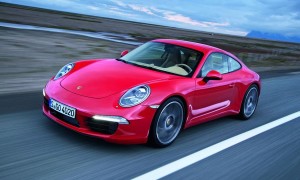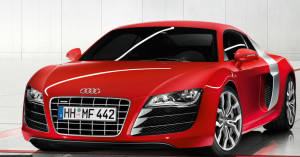Porsche 911 vs Audi R8 V10
TO BE OPEN, HONEST AND frank, this is not the perfectly straightforward four-wheel-drive sports coupe twin test that it might seem. For a start one of these cars is on winter tyres and one is on summer rubber. Then there’s the small issue of whether we have chosen the correct Audi R8 for this comparison. On price, a new Porsche 911 Carrera 4S fitted with Powerkit and carbon-ceramic brakes (like this car) is closer to an R8 V10, but on power it’s identical to an R8 V8. Tricky. You could call it either way. After weeks of little sleep, a few lightly regulated fistfights and much agitated pondering amongst the our staff, we’ve ended up plumping for a newly facelifted R8 V10. It’s not as easy as it seems this job.
In the Racing Yellow corner we have a 911 with ticks in two extremely expensive option boxes. Smelling salts at the ready… The carbon-ceramic brakes cost an eye-watering GBP 5787, while the Powerkit is a staggering GBP 9388. The former seems a slightly unnecessary outlay unless you’re going to spend a lot of time on track, because the standard cast-iron brakes are more than capable of coping with fast road driving and the occasional bit of lappery. The Powerkit looks, on the face of it, even more of a frippery when you work out that you are paying nearly GBP 313 for every horsepower you gain. To save you reaching for the Casio, the output of the 3.8-litre flat-six rises by just 30bhp to 424bhp. Torque remains unchanged at 324lb ft.
 However, delve a little deeper into the Powerkit option and you’ll find that it includes a sports exhaust and the Sport Chrono package that comes with dynamic engine mounts, which would add GBP 2856 on their own. You’ll also be reassured by the fact that the engine changes amount to more than a mere ECU remap. There are reworked and polished intake ports, a reprofiled intake cam and a new variable resonance intake manifold. To combat the extra heat produced, an additional central radiator has also been fitted.
However, delve a little deeper into the Powerkit option and you’ll find that it includes a sports exhaust and the Sport Chrono package that comes with dynamic engine mounts, which would add GBP 2856 on their own. You’ll also be reassured by the fact that the engine changes amount to more than a mere ECU remap. There are reworked and polished intake ports, a reprofiled intake cam and a new variable resonance intake manifold. To combat the extra heat produced, an additional central radiator has also been fitted.
All this still leaves it some way behind the 518bhp R8 V10 on paper, but in reality the performance gap seems much more slender. The V10 is immensely strong and undoubtedly has the edge, but the Porsche’s massaged flat-six revs with such alacrity that it feels mighty close. Both engines do their best work when they’re sprinting for the limiter, the R8 really surging as it reaches 6000rpm and the 911 almost fizzing through its last 1000rpm. The one area where the Porsche has surprisingly but definitely got the upper hand, however, is the sound. Even without the sports exhaust switched on, the 911 yowls in an unfettered way that makes the curiously muffled R8 seem a little lacking in aural sparkle.
 But no sooner has the Porsche got its bluff nose a fraction in front than the Audi tugs back at your emotions with its seating position and gearshift. Low and laid back, the ankle-height view out of the R8 feels pure supercar, especially next to the more upright Porsche. Likewise, while the 991 has the gimmick factor of a seventh ratio in its manual ‘box (which makes changing between sixth and fifth an odd experience) and a clever rev-matching system like that found in a 370Z (essentially an automatic heel and toe), it can’t beat the seductively tactile delight of slicing around the R8’s open metal gate.
But no sooner has the Porsche got its bluff nose a fraction in front than the Audi tugs back at your emotions with its seating position and gearshift. Low and laid back, the ankle-height view out of the R8 feels pure supercar, especially next to the more upright Porsche. Likewise, while the 991 has the gimmick factor of a seventh ratio in its manual ‘box (which makes changing between sixth and fifth an odd experience) and a clever rev-matching system like that found in a 370Z (essentially an automatic heel and toe), it can’t beat the seductively tactile delight of slicing around the R8’s open metal gate.
On chassis dynamics, honours are fairly even. The R8 has the lighter steering, which initially fills your hands with a feeling of guiding the car in a clean and calm manner, pouring it into corners and gliding slickly from one apex to the next. Push harder and the weight of the V10 behind you starts to muscle in on the cornering attitude so that you can feel like you’re struggling to keep the nose tucked into the corner. You can happily overcome this by getting on the power early, and the R8 feels wonderfully controllable driving hard out of a corner, but you can only really do this on well-sighted bends.
By contrast, the 911 feels more mobile through every phase of a corner. There’s a fair bit of squirm in this car because of its winter tyres, but the weighting and feel of the steering is still much more consistent than the Audi’s. Also, this C4S doesn’t have the optional roll-reducing Porsche Dynamic Chassis Control and without it you can really feel and manipulate the archetypal 911 weight balance much more, which is fun. Ultimately the 911 gives you a bit more confidence to attack every corner and then adjust the car’s balance subtly or gratuitously through every phase of it.
What we have here are two five-star cars capable of prickling the hairs on the back of your neck within yards and continuing to entertain you for years. Both are brilliant and there are myriad valid reasons why you might pick one over the other, but for us the 911 just takes the win. Steep though it is, the Powerkit really is worth the money, imbuing the 3.8 with the same addictive top-end pizzazz that we love in the base 911’s smaller 3.4-litre engine.
Would this twin test result have been any different if we’d chosen an R8 V8? It might have been even closer (we maintain that the V8 handles better than the V10) but I doubt it would have been different. Of course it wouldn’t do any harm to get the two together on summer tyres in Wales in a couple of months to find out.
